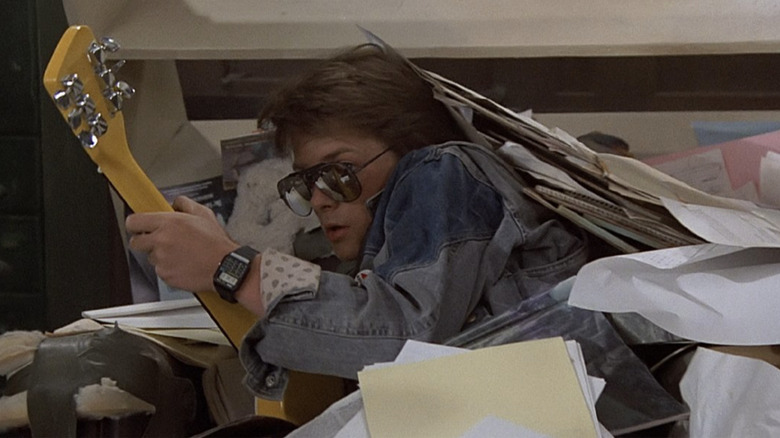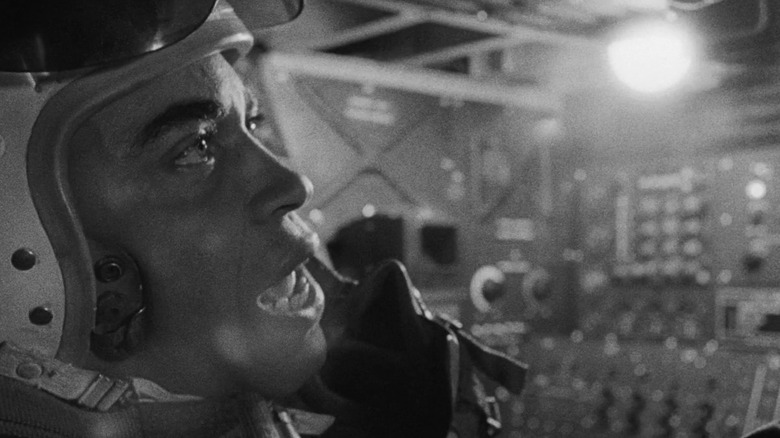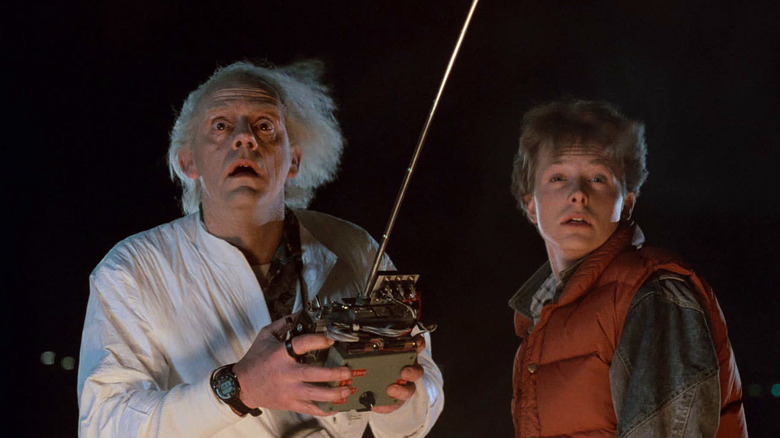Back To The Future Featured A Stanley Kubrick Easter Egg You Probably Missed
In 2025, most moviegoers are used to the concept of Easter eggs and other fun hidden references in films to other media. Most of these references are used in ways beyond mere homage, especially as their presence becomes more commonplace. It's rare to see an Easter egg in a 40-year-old movie that contains multiple layers of meaning. But "Back to the Future" is no ordinary movie.
The film still stands all these years later as one of the greatest time travel movies ever made, and one of the reasons is that co-writers Bob Gale and Robert Zemeckis (who also directed) went through their script with a fine-tooth comb for every last possible setup and payoff. They were simply being responsible to their chosen genres of sci-fi and comedy: time travel stories work best when they focus on a symmetry between the various periods, and every joke needs a punchline. In addition to this, Zemeckis was also working with his career-long theme of looking at American history through a skewed lens, and both men, alumni of USC's film school, were not above paying homage to their influences.
That's why all of these layers contribute to an Easter egg in the movie, which occurs so early and so quickly that you might have missed it. During the opening title sequence, when Marty McFly (Michael J. Fox) is sneaking into the home and lab of Doctor Emmett L. Brown (Christopher Lloyd) when the latter is not there, the teen plugs his guitar into an amplifier that Doc Brown has made. To turn the amplifier on, Marty has to use a key. Just below the keyhole is a label that reads "CRM 114," and it's on screen for barely a second before Fox's hand covers it. If you were lucky enough to catch it, you might've discovered that it's a reference to one of Stanley Kubrick's best films, and not only is it rather ingenious, but it works on several levels.
'Dr. Strangelove' and the birth of CRM 114 as a running gag in Kubrick's films
The name "CRM 114" first appeared in Kubrick's 1964 political satire "Dr. Strangelove or: How I Learned to Stop Worrying and Love the Bomb." That movie is about the fallout (literal and figurative) that occurs after an insane Air Force Brigadier General sets in motion a nuclear attack on the Soviet Union that no one can seem to stop. One of the reasons for this concerns a fictional device called the CRM 114 Discriminator, which is something the military uses during Red Alert periods to communicate with their bombing aircraft secretly and securely. Not only is the mad general the only person with the code to allow communications through, but there's a CRM 114 that is malfunctioning on board one of the bombers, which means that even a successfully transmitted recall code won't stop them from carrying out their destructive mission.
This satirizing of the way various checks, balances, and fail-safe systems put in place by the actual US military during the Cold War could easily be subverted or otherwise misused lies at the heart of "Dr. Strangelove," yet the idea of systems of control breaking down is a core theme of Kubrick's work, too. That's why the director continued to make references to the CRM 114 over several of his subsequent films, turning it into an Easter egg running gag. In "2001: A Space Odyssey," it's the registry number of the Discovery spacecraft, the same ship run by the ultimately malfunctioning HAL 9000 computer. In "A Clockwork Orange," the formula given to the movie's ultra-violent delinquent protagonist is labeled "114," meaning it's "Serum 114," which is Kubrick's little pun on the reference. In the auteur's final film, "Eyes Wide Shut," the mortuary where Tom Cruise's beleaguered doctor becomes drawn further into what may or may not be a conspiracy is located on "Level/Wing C, Room 114." Which is to say, "C RooM 114." Kubrick used the term multiple times not just to be self-referential, but to draw attention to these other instances of technology and/or society breaking down.
How 'Back to the Future' loads CRM 114 with multiple layers of meaning
With all of this in mind, the CRM 114 shout-out in "Back to the Future" is cleverly multilayered. On a film geek level, it's Zemeckis and Gale's tip of the hat to Kubrick's, akin to something like filmmakers continuing George Lucas' "THX 1138" references, or Brad Bird and the Pixar crew keeping the "A113" reference going. On a comedy level, it's a (brief) setup for the gag that immediately follows: CRM 114 refers to a malfunctioning piece of tech, and indeed, Doc's super amp malfunctions in spectacular fashion when Marty turns all the dials up to maximum. On a script level, it's part of our introduction to both Doc and Marty's characters. Doc is a well-meaning but eccentric scientist whose irresponsible nature is evident all over his home (including the plot point of the stolen plutonium sitting just beneath his bed), and the CRM 114 reference draws attention to that. It's also pointing out how Marty, in combination with Doc's technology, can make a bad situation worse. The amp probably wouldn't have exploded if Marty hadn't been misusing it, just as later on, he wouldn't have time-traveled back to 1955 if he had been more cautious.
What's most intriguing is how the reference helps establish the movie's themes, too. "Back to the Future" is a satire as well as an outright comedy sci-fi adventure. This element is often overlooked by casual viewers of the movie, who believe that such elements as Marty's mother, Lorraine (Lea Thompson), falling in love with her future son is supposed to be taken at face value. The film is very intentionally an askew look at American morals, values, and history, and Zemeckis and Gale approach those aspects with both a loving and critical eye. America is a country that promises such beautiful things as freedom and prosperity, but is much less squeaky clean than the image it wishes to project; the idea of Ronald Reagan as President may seem laughable to 1955 Doc, but 1985 Marty isn't laughing. Doc can invent a car that travels through time, in part because of a shady deal that he made with terrorists (whom he double-crossed). However, the car isn't some sterling example of engineering, but the DeLorean, a vehicle famous for failing to catch on.
CRM 114 doesn't just call back to Kubrick on a surface level, but on a deeply thematic one. Whether it's the Discriminator or the DeLorean causing the trouble, both are indicative of how beautifully screwed up the United States is.


